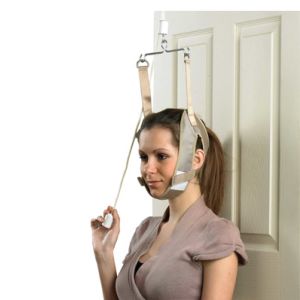Neck Traction
1 reviews
from as low as £39.95
What is a Neck Traction Device?
The term "traction" encompasses various applications in the healthcare field, generally involving the utilization of pulling forces to address joint, bone, or muscle issues. Traction is frequently employed in physical therapy and orthopedics for the treatment of the following conditions:
- Persistent muscle spasms
- Dislocations
- Fractures
- Deformities
Traction is commonly applied to the neck, spine, arms, legs, and pelvis to assist with muscle, joint, or bone problems.
The principle of traction involves the application of force and counterforce in opposing directions. This typically entails pulling in one direction while adjusting a bed or utilizing body weight as a counterweight in the opposite direction. For instance, traction is commonly used for treating broken limbs. You may have observed someone with a wrapped leg connected to a pulley system with weights, suspended in midair. The pulley aids in the pulling action while the individual's body weight serves as the counterforce. This technique helps align the bones correctly for optimal healing.
Neck traction, also known as cervical traction, employs pulling force on the neck. It often involves stretches or exercises designed to alleviate neck pain. Some neck traction methods can involve devices that can be used at home.
Neck traction can be categorized into three different types, each serving specific purposes.
Mechanical cervical traction involves the use of specific devices to apply traction to the head and neck while you lie down. A harness is attached to your head, and your therapist connects it to a machine that generates the traction force, stretching your head and neck away from your body.
Another form of mechanical cervical traction involves the use of a Halo device or Gardner-Wells tongs. These devices consist of a ring that is affixed to the skull. They can be attached to a vest for long-term wear, providing neck stabilization, or connected to a harness. A machine or weights are then applied to the Halo device to exert the pulling force.
Over-the-door cervical traction is a type of neck traction that can be conducted in a therapy office or at home. It involves securing a harness or cushioned sling around your head and neck. The harness is then fastened to a rope and pulley system positioned over a door. In some cases, weights are added to the end of the rope, or you can manually pull the rope to stretch the neck.
Manual cervical traction: This technique involves a therapist using their hands to apply gentle pulling force, gradually moving your head and neck away from your body. They typically hold the traction for approximately 10 seconds before releasing it, and they may perform the procedure at various angles.
Manual cervical traction is utilized in the following situations:
- Diagnostic purposes: It helps healthcare professionals assess your neck condition.
- Massage or physical therapy: This form of traction is employed during these treatments to delicately stretch the muscles.
- Chiropractic adjustment: Manual cervical traction assists chiropractors in gently stretching the neck.
- Pain relief: It can be used as a therapeutic measure to alleviate neck pain.
Are Neck Traction devices safe?
Cervical traction is generally considered safe, but it's important to note that individual outcomes may vary. It is crucial that the treatment is completely pain-free.
It is possible to experience certain side effects, including headaches, dizziness, and nausea, when adjusting your body during the procedure. In some cases, these side effects may even result in fainting. If you encounter any of these symptoms, it is recommended to cease the traction immediately and consult with your doctor or physical therapist to discuss these effects.
Benefits of Neck Traction
Neck traction is a therapeutic technique employed in physical therapy settings, emergency rooms, and occasionally at home. It is a non-invasive approach used to stabilize fractures or dislocations in the neck and spine. Neck traction is also beneficial for addressing the following conditions:
- Arthritis
- Pinched nerves
- Cervical disc disease
- Misalignment of cervical bones
- Spondylosis (spinal degenerative disc disease)
Neck traction offers specific advantages, including:
- Preventing muscle shortening and contractions
- Reducing pressure on affected areas
- Restoring blood flow and nerve function
- Providing stability to the neck
- Correcting deformities
- Allowing injuries to rest
- Relieving pain
Individuals with neck problems often experience symptoms such as numbness, tingling in the arms and legs, and significant pain. While the exact mechanisms of how neck traction works are not fully understood, it is believed that traction helps relieve pressure on nerves and promotes muscle relaxation, resulting in pain relief.
Traction may be applied intermittently, alternating with periods of rest to enhance blood flow to the nerves. This approach is typically used for degenerative disc disease and limited neck mobility. In sustained traction, weights or force are applied for longer durations, typically up to one hour. This method is primarily employed for muscle pain and herniated discs.
Risks of Cervical Traction
Problems from neck traction are rare. People who have certain health conditions probably shouldn’t use this therapy. These include:
- Torticollis
- Aortic aneurysm
- Osteoporosis
- Spinal cord tumor
- Major anxiety
- Untreated high blood pressure
- Recent neck injury or surgery
- Chronic cervical disc degeneration
- Pregnancy
Your physical therapist or doctor will decide if you should use neck traction and if an at-home traction device is a good idea.
If you have any of the following symptoms during neck traction, you should stop immediately and be assessed by your doctor:
- Headache
- Nerve pain in your extremities
- Pain suddenly goes away
- Neurological symptoms
- Muscle weakness
- Numbness
- Fainting
- Confusion
- Vision loss
- Tremors
- Seizures
Neck traction is one way to help with neck pain and other problems. Your muscles and tissues and spine are sensitive to damage, so it’s best to get advice from your doctor first.



